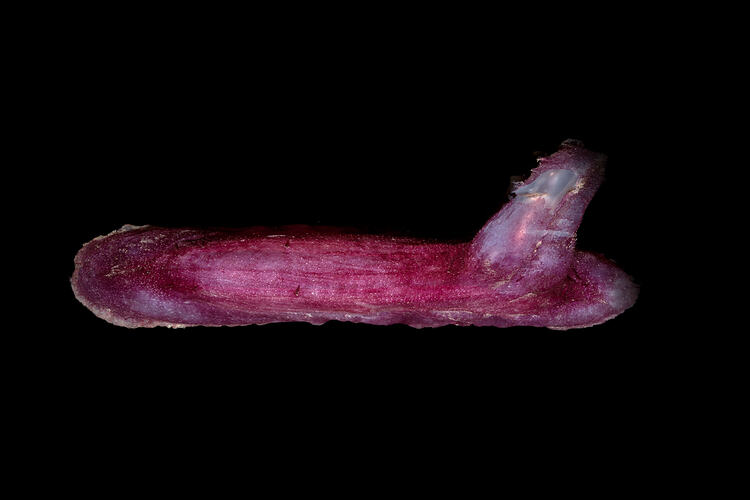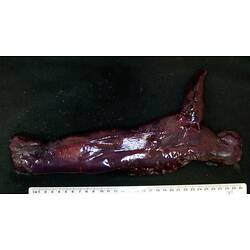General Description
Purple to violet; soft, gelatinous, roughly cylindrical, flattened ventrally with anterior brim; ventral mouth and anus; large, unpaired sail-like dorsal appendage towards posterior of body; 18 tentacles with firm discs and knobbed margins; minute venterolateral tube feet, paired rows of larger mid-ventral tube feet; thin, paired dorsal papillae; ossicles arched crosses with spines; up to 32 cm long with dorsal appendage up to 12cm .
Biology
Psychropotes longicauda is a large purple species with a prominent sail or fin-like dorsal appendage. The function of this unpaired dorsal appendage is unknown in adults, though is likely to assist with swimming or floating as it does in juveniles.
Psychropotes longicauda has one of the largest eggs of any echinoderm (up to 4.4 mm in diameter), with likely direct development to swimming juveniles. Adult Psychropotes species have been seen swimming in ROV (Remotely Operated underwater Vehicle) footage, but adult swimming is thought to be facultative - i.e. only used when needed.
This species is found in various oceans around the world, typically on abyssal plains at a depth of ~2000 to 5000 m. As a benthic deposit feeder and detritovore, it spends most of its adult life crawling along the seafloor and feeding intermittently by sifting food from the sediment with its feeding tentacles. As with other sea cucumbers this ability to churn the ocean floor like an earthworm provides a valuable ecological service called 'bioturbation'. A number of deep-sea sea cucumbers like this have also been observed to display bioluminescence. Psychropotes longicauda is a cryptic species complex, so its current description and cosmopolitan distribution is likely to change in the future as further research splits it into more species.
Distribution
Worldwide. In Australia currently recorded from deep sea off Queensland, NSW, Tasmania, and South Australia.
Habitat
Deep sea marine benthic species occurring worldwide at lower bathyal to abyssal depths. Cosmopolitan, abyssal plains (~2000 to 5000m)
More Information
-
Animal Type
-
Animal SubType
-
Fast Fact
Towards the posterior end of the dorsal surface it has a large, dorsal 'shark fin' or 'sail' like appendage.
-
Brief Id
Soft body, convex dorsally, slightly flattened anteriorly, and flattened ventrally with long sail-like appendage on dorsal surface, purple/violet in colour, 18 feeding tentacles, ventral tube feet.
-
Colours
Purple
-
Maximum Size
32 cm
-
Habitats
-
Diet
Organic matter
-
Endemicity
-
Depths
Deep ( > 30 m)
-
Water Column Locations
On or near seafloor
-
Taxon Name
-
Scientific Author
Théel, 1882
-
Common Name
Sea Cucumber
-
Other Names
long-tailed sea cucumber , gummy squirrel
-
Phylum
-
Class
-
Order
-
Family
-
Genus
-
Species Name
longicauda


